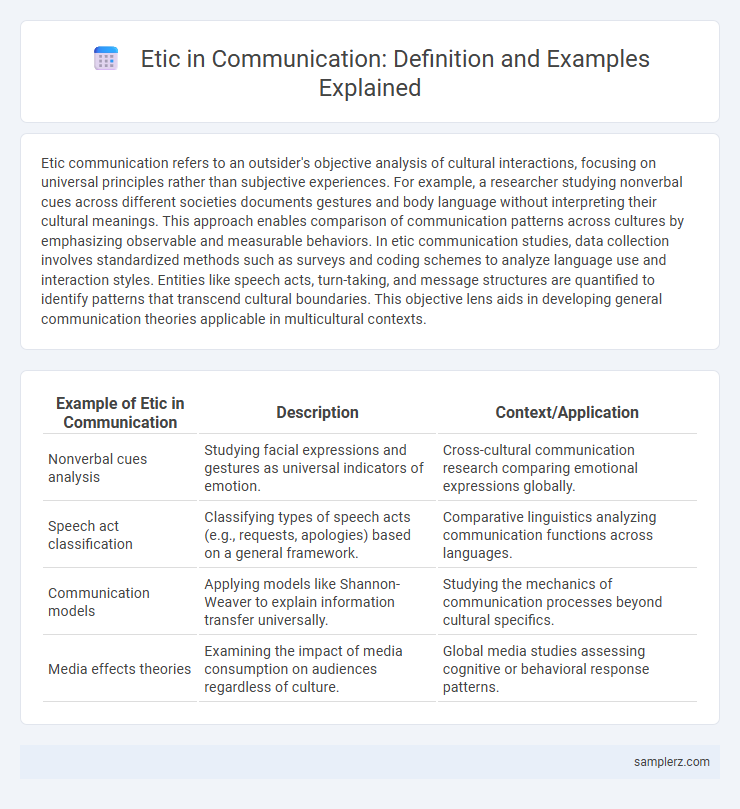Etic communication refers to an outsider's objective analysis of cultural interactions, focusing on universal principles rather than subjective experiences. For example, a researcher studying nonverbal cues across different societies documents gestures and body language without interpreting their cultural meanings. This approach enables comparison of communication patterns across cultures by emphasizing observable and measurable behaviors. In etic communication studies, data collection involves standardized methods such as surveys and coding schemes to analyze language use and interaction styles. Entities like speech acts, turn-taking, and message structures are quantified to identify patterns that transcend cultural boundaries. This objective lens aids in developing general communication theories applicable in multicultural contexts.
Table of Comparison
| Example of Etic in Communication | Description | Context/Application |
|---|---|---|
| Nonverbal cues analysis | Studying facial expressions and gestures as universal indicators of emotion. | Cross-cultural communication research comparing emotional expressions globally. |
| Speech act classification | Classifying types of speech acts (e.g., requests, apologies) based on a general framework. | Comparative linguistics analyzing communication functions across languages. |
| Communication models | Applying models like Shannon-Weaver to explain information transfer universally. | Studying the mechanics of communication processes beyond cultural specifics. |
| Media effects theories | Examining the impact of media consumption on audiences regardless of culture. | Global media studies assessing cognitive or behavioral response patterns. |
Understanding Etic Perspectives in Communication
Understanding etic perspectives in communication involves analyzing cultural interactions through an external, objective lens that identifies universal patterns across diverse societies. For example, researchers studying nonverbal cues such as eye contact or gestures in different cultures apply etic approaches to evaluate their meanings and functions beyond individual cultural contexts. This method enhances cross-cultural communication by highlighting commonalities that facilitate mutual understanding despite cultural differences.
Key Characteristics of Etic Approaches
Etic approaches in communication emphasize universal principles and cross-cultural comparisons, focusing on observable behaviors and standardized criteria. Key characteristics include the use of outsider perspectives, objective measurements, and the aim to identify common patterns across diverse cultures. This enables researchers to develop generalizable theories applicable beyond a single cultural context.
Cultural Universals in Communication Patterns
Etic approaches in communication emphasize cultural universals, such as eye contact, turn-taking, and facial expressions, which are consistent across societies. Researchers analyze these universal patterns to understand how people from diverse cultures convey meaning and regulate conversations. Studying etic communication patterns helps identify commonalities that facilitate cross-cultural interactions and reduce misunderstandings.
Cross-Cultural Theories and Etic Frameworks
Etic frameworks in communication analyze behaviors across cultures using universal categories like Hall's proxemics theory, which examines spatial use globally. Cross-cultural theories such as Hofstede's cultural dimensions employ etic perspectives by quantifying cultural values like individualism and power distance for comparative analysis. These approaches enable researchers to identify overarching communication patterns and predict intercultural interactions effectively.
Examples of Etic Analysis in Verbal Interaction
Etic analysis in verbal interaction involves examining communication behaviors from an outsider's perspective, focusing on universal categories such as turn-taking, speech acts, and pauses. For instance, researchers may analyze classroom discussions across cultures to identify consistent patterns in question-response sequences or politeness strategies. This approach helps reveal underlying structures and norms that govern spoken communication globally.
Etic Observations in Nonverbal Communication
Etic observations in nonverbal communication involve analyzing universal behaviors such as facial expressions, gestures, and proxemics that transcend cultural boundaries. For example, interpreting a smile as a sign of friendliness or eye contact as a form of engagement provides insights applicable across diverse cultures. This approach allows communication researchers to identify common patterns in body language, facilitating cross-cultural understanding and reducing misinterpretations.
The Role of Etic Methods in Intercultural Research
Etic methods in intercultural communication research involve analyzing behaviors and practices from an outsider's perspective, allowing for comparison across cultures. These techniques use standardized categories and concepts, facilitating objective data collection and cross-cultural generalizations. By focusing on universal communication patterns, etic approaches help identify underlying similarities and differences in interaction styles worldwide.
Comparing Etic and Emic Communication Approaches
Etic communication approaches analyze interactions from an outsider's perspective, identifying universal patterns across cultures, such as nonverbal cues like eye contact and gestures. Emic methods focus on understanding communication within a specific cultural context, emphasizing insider meanings and culturally unique practices like language idioms or storytelling traditions. Comparing etic and emic approaches reveals how global communication strategies benefit from universal norms while respecting cultural nuances for effective cross-cultural interaction.
Case Studies: Etic Perspectives Across Cultures
Case studies highlighting etic perspectives in communication reveal cross-cultural behaviors by analyzing universal patterns such as nonverbal cues and information-sharing norms. Researchers often use frameworks like Hall's high-context and low-context communication styles to compare diverse cultures, focusing on standardized observation rather than insider viewpoints. These etic analyses enable objective evaluations of communication practices in multicultural environments, improving global interaction strategies.
Challenges of Applying Etic Concepts in Communication
Applying etic concepts in communication faces challenges such as misinterpretation of cultural norms and values due to outsider perspectives, which can lead to misunderstandings and ineffective messaging. Standardized communication models often overlook nuanced cultural contexts, resulting in communication barriers and reduced relational trust. These difficulties highlight the complexity of balancing universal communication theories with diverse cultural realities.

example of etic in communication Infographic
 samplerz.com
samplerz.com